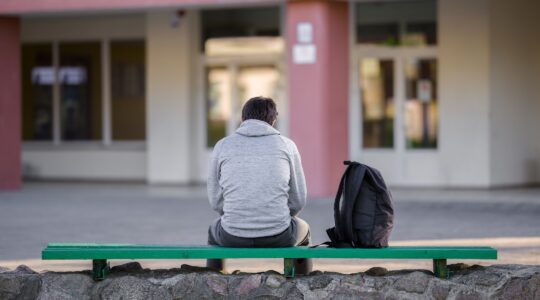Few architects have designed as wide a variety of buildings as Moshe Safdie. The Haifa-born architect is the creative brains behind Israel’s Ben-Gurion Airport, public libraries in Vancouver and Salt Lake City, as well as a splashy casino in Singapore.
This fall, the National Academy Museum will be exhibiting “Global Citizen,” a touring survey of the influential architect’s prodigious career. For more than 50 years, Safdie has created functional, beautiful and humane spaces around the world. His practice is headquartered in Boston and has offices in Jerusalem, Toronto, Singapore and Shanghai. At 77, he is constantly traveling and his firm continues to take on new projects.
Although Safdie’s work has sometimes elicited controversy, he is widely recognized for his sensitivity to human needs. He is known for incorporating natural surroundings into his buildings. The architect does not shy away from symbolism in his work, and he is not afraid of beauty. This year he received The American Institute of Architects’ highest honor, the Gold Medal.
With each project comes a drastically new setting and with it, new architectural responses. In a phone interview with The Jewish Week, Safdie explained his method, which he feels is comprised of two components: the site and the context. At the beginning of the planning process he will “draw inspiration from the site, deciphering secrets from it.” He will ask himself what are the “unique conditions of this place that need to be addressed.” From there, he will interpret the space’s use.
The “Global Citizen” exhibit, which was curated by independent curator Donald Albrecht and has already made stops at the National Gallery of Canada, Crystal Bridges Museum of American Art in Bentonville, Ark., and the Skirball Cultural Center in Los Angeles, offers a glimpse into Safdie’s career through models, photographs, original drawings and sketchbooks. Visitors will be able to see well-known Safdie sites from their planning stages through photos of completion. Newspaper clippings documenting critical reaction and videos contextualizing the work are displayed throughout.
Born in Haifa in 1938, Safdie remains influenced by the architecture of this northern Israeli city. He has described Haifa as a “coastal, pedestrian Bauhaus hill town” with buildings that are geometric and terraced.
Safdie remains a passionate Zionist, and has completed many projects in Israel. An entire section of “Global Citizen” is dedicated to his buildings there.
One Israeli project featured in the show is the Yad Vashem Holocaust memorial, which was finished in 2005. The museum combines a poignant experience indoors followed by the uplifting view of Jerusalem’s forested hills. Safdie remarked that this for him has not only been a successful project, but “emotionally the most challenging.”
The commercial Mamilla Center in the Old City of Jerusalem, which he completed in 2009, was a very different undertaking. This mixed-use development includes a luxury hotel, apartments, offices, and a retail promenade.
In his plans for the new city of Modi’in in central Israel (1996), Safdie ensured that there would be parks and an efficient road system. He designed the layout of the city, its community center and retail district. The residential areas of the city were sold to developers who built using their own designs, allowing for varied housing types.
Safdie’s work extends far beyond Israel, and another section of the show focuses on his North American buildings. In Ottawa, he won a competition to build the National Gallery of Canada; in Wichita, Kansas he planned The Exploration Place Science Museum; in Los Angeles he designed the Skirball Cultural Center, and in Salt Lake City he conceived the public library which has become a popular meeting spot and wedding venue.
Recently he has begun working more in Asia. He built the Khalsa Heritage Center, a Sikh museum, in Anandpur Sahib, Punjab, India in 1999, and was hired to design the Marina Bay Sands resort in Singapore (2010) after meeting Sheldon Adelson at the opening ceremony of Yad Vashem.
“Global Citizen” also concentrates on Safdie’s Habitat works. Habitat67, a residential complex in Montreal, was the project that launched his career while he was in his 20s. The exhibit will feature plans for both unrealized Habitat schemes (including one for New York) as well as photographs of what has been built.
Albrecht finds that Safdie’s biggest strength is his ability to “express the aspirations of the people” for whom he’s working.
“Architecture is a social art,” noted Albrecht in a phone interview. “It’s not about making sculptures. It’s about fulfilling peoples’ goals in the designs.”
Though Safdie has many important projects behind him, he does not have the celebrity status of some of his “starchitect” peers such as Frank Gehry, Jean Nouvel and Robert Stern. Albrecht speculates that this might be because of Safdie’s use of metaphor in his work, which the mainstream press may not appreciate. Another possibility, according to Albrecht, may be that Safdie does not have a signature style that he imposes on all of his buildings. It could also simply be the very thing being celebrated in this exhibit: his global sensibility. Neither Safdie nor his buildings are concentrated in one place; his work can be seen all over the world.
Incidentally, Safdie mentioned that he is working on a residential project in New York City on land purchased from and adjacent to the Marble Collegiate Church on Fifth Avenue and 29th Street. The as-yet unnamed building is currently in the planning stage and is scheduled to be publicly unveiled this month.
“Global Citizen” opens Sept. 10, and runs through Jan. 10, 2016, at the National Academy Museum (1083 Fifth Ave., 212-369-4880, nationalacademy.org).
The New York Jewish Week brings you the stories behind the headlines, keeping you connected to Jewish life in New York. Help sustain the reporting you trust by donating today.




